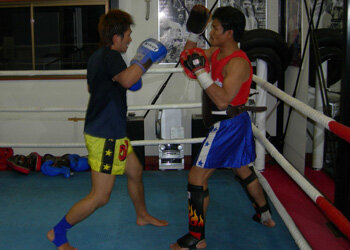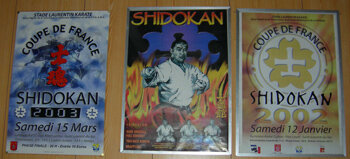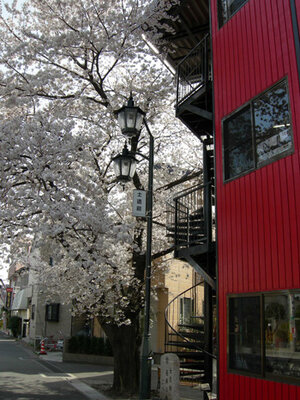Second part:
"This is the second part of my April 2006 dojo diary. I continue training with Reku-san and meet Shidokan shihans from all over the world as they come to a meeting in Ito dojo. Together with students from Waseda University we compose a haiku to present to the Tokorozawa dojo.
Friday. Kancho Soeno called by the dojo in the morning. I was the only one in, reading in my room before heading up to the University, so it was quite a surprise to see Kancho's head pop round the door. He gave a big smile and said hello. He was enjoying the cherry blossom. Afterwards I heard him clap to the shrine in the dojo.
In the evening I trained with Reku-san. We worked on keeping my body upright around the centre line - I need to move around this line to keep the attacks sharp and focused. Reku introduced the combination of jab-cross, cross, cross-hook, cross. The rhythm is Bab-bab, Bab, Bab-bab, Bab. I had to be careful to return sharply to a good stance to keep shape and balance. For the left leg kick the first step forward is with the right, kick, left leg down to right, then right leg back. The movement is one-two-three rather than a switch.
It is cold outside, but the dojo is heated by a space heater between the boxing ring and racks for pads and gloves. A tiny old woman, bent with age, wrapped in a shawl, came in and sat by the fire. Everyone just kept on training, nobody broke rhythm.
After about half an hour she said thank you and left. I stopped training at 9.30 p.m. and went to bed at 10.00. About 10.30 three visitors arrived for the Ito shihan meeting, one from Belgium the other two from Spain. They went out with Shihan Tatsuichi and came back around 2.00 a.m.

Saturday. It's very chilly in the morning and the visitors complain about the cold. I guess I'm used to it by now. When I got back to the dojo in the late afternoon Tatsuichi's wife Yuko was there with a tiny baby, only four days old. So sweet! The whole family came out to take pictures of the baby under the cherry tree.
I chat with the shihan from Belgium and we go down to the dojo and train on the bags. When Reku-san arrives we work together on hizageri. It's getting a lot better. Reku looked a bit surprised when I finally got the hang of it. I'm still messing up the combinations. I can get them OK on the bags, but tend to rush them when confronted by focus mitts and so lose the sequence. I need to think about rhythm more, relax, not to rush, and finish each technique. The dojo is pretty busy. The visitors went out for dinner around 10.00 p.m., got back late and then are up before 6.00 a.m. for the journey to Ito.

Sunday. All is quiet now, I think I'm the only one left here. Everyone is at Ito dojo. I spent the day at the University and then turned in early for bed. There is a lot of rain in the evening and night.
The black spiral staircase of the dojo is speckled with white cherry petals. Monday. After the rain it is a beautiful clear sunny morning.
On the train out to Kotesashi I can see the hills surrounding Tokorozawa, and on the left-hand side Mt Fuji covered in snow. It must be nearly 100 km away, but looks much closer.
When I get to the University I climb to the top of the building with Prof Amano to try and get a photograph, but there is a strong wind blowing and it is difficult to hold still. Prof Amano tells me that this spring wind is called
Hana Arashi - flower storm. The wind blows steadily throughout the day.
By the afternoon dust obscures the horizon and the hills are again hidden from view. It is odd to think that Mt Fuji is there all the time but I have only seen it once. Evening training is much better today, my muscles are getting used to it and I'm a few kilos down from office weight.
The shihans are back from Ito. Reku says they were up until 3.00 a.m. They bring instructions from JJ that I have to work on Shikon no Kata while I am here so that I can bring it back to the UK. The shihans seem to have had a pretty good meeting, and there is a lot of intense discussion. I went into the supermarket to get some fruit juice and bought a packet of what I thought were special Japanese nuts, which I didn't recognise and of course could not read what it said on the packet. When I tried them, I found they aren't nuts, they are beans and not a bit crunchy. Still, they taste quite nice and I'll eat them for breakfast.
Shinyobu called to chat to the shihans from Costa Rica, she is having dinner with JJ and Yuka-san, so I have a chat with JJ. The Ito meeting sounds fun. JJ said the training with Kancho was quite hard, all kihon, with the dojo very hot humid and crowded with about 6o people, mostly blackbelts, after a while the floor was covered in sweat and slippery. But very enjoyable especially with so many blackbelts kiaing at the same time and encouraging each other when the going got tough and Kancho coming round hitting people with a shinai if stances were wrong. Kancho told everyone to do press ups on the knuckles, but he didn't say when to stop. So people did, say 50, then stopped, then had to carry on and do some more.
Tuesday. I worked on Shikon no kata yesterday afternoon with the young brown belt who knows a lot of kata and think I have it sorted now. The energy gathering bit is definitely in back stance not front stance; the second kick is a side snap kick to the right and not a back kick; and the mwashi uke series at the end are two circles forward in sanchin dachi, one in the reverse direction backwards into back stance.
After kata practice I trained on the bags and then with Reku before the karate class at 6.30. Although I still muddle some combinations, particularly those with upper cuts, sparring with Reku is really coming on and much smoother than before. We went through three rounds of constant combinations with nice flow, which felt pretty good.
Shihan Tatsuichi took the karate session and was joined by some of the visiting shihans. Afterwards he went through Saifa kata which is based around defence and attack in the dark. To prove the point he switched off the lights and demonstrated the bunkai with the young brown belt student.
After training Shihan Tatsuichi invited the visiting shihans and myself to dinner at the sushi restaurant just down the road from the dojo. The restaurant is managed by a former student of the dojo so we were given a private room and wonderful food. Two of the visiting shihans are from the island of St Martin in the Caribbean and showed us their plans for a Caribbean Shidokan dojo. The table was low, Japanese style, when I got up the muscles on the inside of my thigh went into cramp. I hadn't stretched off after training. Getting my shoes on was tricky.
Wednesday. Fresh green leaves are unfolding on the cherry tree by the dojo, signalling the end of the flowering period. Petals are beginning to fall in drifts.
We held the last student seminar today at the University, so in the evening we went out to an Okinawanan restaurant in Tokorozawa with all the students and Prof Amano. We all sat round a low table on a wooden bench and started out with a glass of beer, special seaweed and other delicious Okinawanan food. We aim to write a haiku to present to the dojo. I start out with a Japanglish hybrid "Hana arashi, Petals fall on the staircase, View of Mt Fuji".
The idea behind the haiku is that there may be disagreements, represented by the spring flower storms and falling petals, but Fuji-san is there all the time, and can be seen rising up after rain has cleared the air. One of the students comes up with a translation for the last line "Fuji no yama". So we're doing pretty well, just the middle line to do. But then there is a lot of discussion. The problem is that we have cherry blossom twice, once in "Hana arashi", and again with the petals on the staircase. This won't do at all. In the meantime I've finished my beer and a huge glass of special Okinawanan Awamori sake appears in front of me, together with a top up for the beer. The sake is pretty strong.
Another haiku line is suggested "Kaze no mukouni" - meaning the wind from behind, or over there, to represent the distance to Fuji san. The students think I should try some 8 year old sake, Zuisen, so another glass is lined up to join the beer and Awamori.
One of the students proposes the line "Fuji no mine" - which represents the curve of Mt Fuji. Of course, the 8 year old Zuizen now needs to be contrasted with Shochu from central Japan, and another glass appears. I now have four glasses to choose from.
We start discussing the poems of the haiku master Matsuo Basho. One of the students is from Basho's home town, Ueno, and reveals that that the town is also famous for its ninja school. Naturally enough, what with all that beer and sake, we have a lively discussion about whether or not Basho was a ninja which ends with the students practising finger-tip press ups on the bench.
Meanwhile, one of the students who is a haiku specialist has been working away. This is his haiku: "Yukifuji no, Kubimoto kazaru, Hana arashi". Which means something along the lines of the cherry blossom petals blown by the spring flower storm make a snow collar for distant Mt Fuji. We all agree this is pretty damn good and another student whose hobby is calligraphy writes the haiku in beautifully drawn characters and slots the finished poem into a decorated mount ready to be presented to the dojo.
Thursday. I present the haiku to Shihan Tatsuichi after Karate training.
Sunday. I'm up early and on the 6.30 am bus from Tokorozawa to Narita, returning back to England."
 Good fight!
Good fight!


